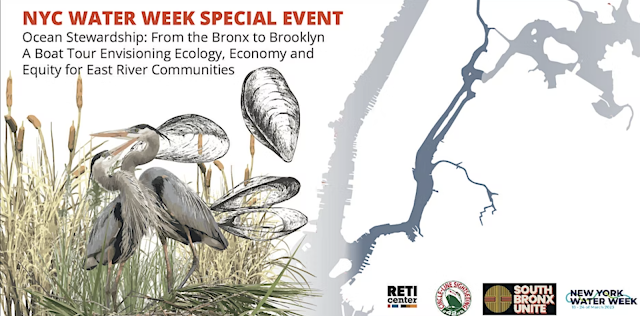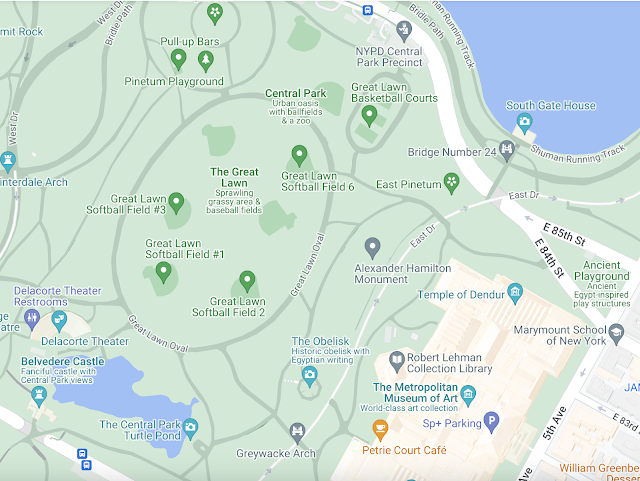On Friday, from the East River Ferry Pier at E. 35th Street, my wife and I took a three-hour waterfront tour of "New York's Sixth Borough," its sprawling and eclectic waterfront. Though the weather was cold, misty and windy, we bundled up and got ready to see a city that very few people get a chance to see.
We motored from 35th Street, past Roosevelt Island, through Hell's Gate, up to where the Bronx River meets the Harlem River meets the Long Island Sound meets the estuarine flow of the East River.
Then we went around South Brother Island, the waste transfer stations of the South Bronx, the Queens side of Roosevelt Island, past the new, gleaming and vertical Long Island City, past new, gleaming and vertical Williamsburg, Brooklyn, past Sunset Park, Brooklyn, past Red Hook, Brooklyn, out to the Statue of Liberty, around asbestos-coated Governor's Island, back to the Ferry Landing at four--in time to walk to Sophie's for a good, hearty Cuban dinner.
Most of the 150 people on the boat were involved with one of the sponsor organizations. But there were three eighth-graders there with a dad. Their middle school was involved somehow and the bravest of the kids stuck a microphone in my face and asked if he could interview me for his school's radio station. The most absolutely charming and most absolutely New York thing about this was the kid's name: Achilles.
I'm not sure how many New Yorkers in 2023 are named Achilles and grow up keeping their eyes on their heels.
Achilles asked me what I thought about the whole shebang. My answer is the reason behind this post today. I said, "As a lifelong New Yorker, I grew up at a time when you could practically walk across the East River, it was so laden with sewage and carcasses. Today, the city has a vibrant ferry system and a string of parks along the waterfront (at least along the rich man's waterfront) and in the summer, we see people jet-skiing, kayaking and we see sea birds and fishers. There are beavers in the Bronx River, harbor seals on the West Side, and dolphins swimming past the UN. I'm here because I heard about the 'Billion Oyster Project' and I wanted to learn more."
A couple days after this, on Sunday morning, the sun rose bright and the temperature was inching into the 60s. My wife and I laced up our $200 synthetic sneakers and headed out to Central Park for our daily three-to-four-mile walk.
As the dogwoods, the forsythia and cherry blossoms showed in early pastel bloom, we circled the Great Lawn Oval, just west of the Met, just south of the reservoir and just north of Belvedere Castle. It's about 5/8ths of a mile around and the grass in the center of the oval is home to six baseball diamonds with overlapping venn-ed outfields.
The City had again devoted disproportionate resources to the playgrounds of the rich, and the well-drained fields were covered with genetically modified grass engineered to withstand life in the city. With the warmth of the sun shining on it, the dull brown of winter ground cover was turning a deep movie-star's-eyes green.
These were the fields where I plied my baseball career as a 14 to 17-year-old more than half-a-century ago. When I first played on these fields, the last Civil War veteran had died only 20 years earlier. And just five years earlier, large swaths of the population were segregated de jure from other large swaths.
As a tenth-grader, just 15 years old, I had moved up from baseball cleats to big-league Riddell baseball spikes. Riddell spikes, a Rawling's "finest in the field" glove and a Hillerich and Bradsby Louisville Slugger ash-wood bat were the pre-Nike tools of my trade.
Our team bus squealed to a stop alongside the Museum of Natural History on Central Park West and we boys grabbed a duffle of equipment and scampered across the street to our appointed field. The ancient cobbles of Central Park West showed through the lox-thin layer of asphalt, and I remember the abrade and sparks of my spikes on the sad stone.
This was the bottomed-out city. The heroin stupored, the switchblade sharp, the brink of a riot city that much of Amerika had hoped would drop dead and die. When Travis Bickel was in Times Square, not Elmo.
The fields themselves were a battleground. Tire-tracks sculpted in the mud lined the outfield so it looked like a junkie's forearms. Drug deals happened on the field during the game. "Hey, wouldja beat it? He's a pull-hitter" and there was way more dust and rat dander than greenery.
Today, this morning, the fields smiled. Though they were hurricane-fence closed for the season, even in early and still chilly spring, they were ready for the return of the summer game. Forget about sports and everything else today having been ruined because they've been sold to the highest bidder. Behind the chainlink, fenced off from rapacious capitalism, was hope and innocence.
Cities, ballfields, waterfronts, oceans, people, agencies, lives, hopes and dreams are not stolid like cinder blocks. As Edward Gibbon might have writ, they rise and fall, they live and breathe, they crash and burn, and they flutter and fly.
As modern people in a fast-moving world, in many cases, we've stopped considering or forgotten how to consider, how long time is.
A long time isn't a week or a month or a season or a year. It might be 50 years or a thousand.
The hurt heal. The bad reform. The dying spark.
Things regenerate.
Even smiles on the lips of gloomy old copywriters.
Especially gloomy old copywriters who keep putting one foot in front of the other and keep moving forward.
-






No comments:
Post a Comment